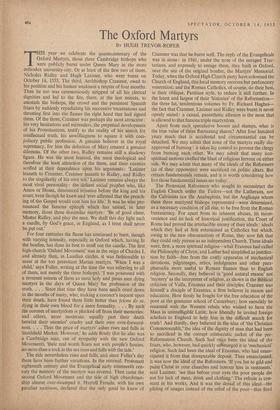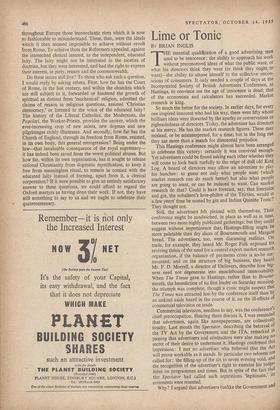The Oxford Martyrs
BY HUtH TREVOR-ROPER THIS year we celebrate the quatercentenary of the Oxford Martyrs, those three Cambridge bishops who were publicly burnt under Queen Mary in the more orthodox university-city. Or at least of the first two of them, Nicholas Ridley and Hugh Latimer, who were burnt on October 16, 1555. The third, Archbishop Cranmer, owed to his position and his human weakness a respite of four months. Then he too was ceremoniously stripped of all his clerical dignities and led to the fire, there, at the last minute, to astonish the bishops, the crowd and the persistent Spanish friars by suddenly repudiating his successive recantations and thrusting first into the flames the right hand that had signed them. Of the three, Cranmer was perhaps the most attractive : his very hesitations and surrenders, the perpetual development of his Protestantism, testify to the reality of his search for intellectual truth, his unwillingness to equate it with com- pulsory public profession. A genuine believer in the royal supremacy, for him the defection of Mary created a genuine dilemma. Of the other two, Ridley remains still a shadowy figure. He was the most learned, the most theological and therefore the least attractive of the three, and their enemies scoffed at their dependence upon his arguments : 'Latimer leaneth to Cranmer, Cranmer leaneth to Ridley, and Ridley to the singularity of his own wit.' Latimer remains always the most vivid personality : the defiant social prophet who, like Amos or Hosea, denounced injustice before the king and his court, even though he knew and 'ever affirmed that the preach- ing of the Gospel would cost him his life.' It was he who, pro- nounced the famous epitaph which has united, in later memory, those three dissimilar martyrs : 'Be of good cheer, Master Ridley, and play the man. We shall this day light such a candle, by God's grace, in England, as I trust shall never be.put out.'
For four centuries the flame has continued to burn, though with varying intensity, especially in Oxford which, having ,lit the bonfire, has done its best to snuff out the candle. The first high-church 'Oxford Movement' was in the reign of Charles I, and already then, in. Laudian circles, it was fashionable to sneer at the too protestant Marian martyrs. 'When I was a child,' says Fuller, writing at the time (he was referring to all of them, not merely the three bishops), `I was possessed with a reverent esteem of them as most holy and pious men dying martyrs in the days of Queen Mary for profession of the truth. . . . Since that time they have been much cried down in the mouths of many, who, making a coroner's inquest upon their death, have found them little better than felons de se, dying in their own blood fora mere formality. . . . By such' the coronet of martyrdom is plucked off from their memories; and others, more moderate, equally part their death betwixt their enemies' cruelty and their own over-forward- ness. . . . Thus the price of martyrs' ashes rises and falls in Smithfield Market.. However,' he adds firmly (for he also was a Cambridge man, out of sympathy with the new Oxford Movement), `their real worth floats not with people's fancies, no more than a rock in the sea rises and falls with the tide.'
The ,tide nevertheless rises and falls, and since Fuller's day there have been further variations. In the rational, Protestant eighteenth century and the Evangelical early nineteenth cen- tury the memory of the martyrs was revered. Then came the second Oxford Movement and the tide of high churchman- ship almost over-swamped it. Hurrell Froude, with his own peculiar nastiness, declared that the only good he knew of Cranmer was that' he burnt well. The reply of the Evangelicals was in stone : in 1841, under the nose of the enraged Trac- tarians, and expressly to enrage them, they built in Oxford. near the site of the original bonfire, the Martyrs' Memorial. Today, when the Oxford High Church party have colonised the Church of England, this local memory receives but perfunctory veneration; and the Roman Catholics, of course, do their best, in their oblique, Parthian style, to reduce it still further. In the latest and largest of their `histories' of the Reformation— the three fat, tendentious volumes by Fr. Richard Hughes— the fact that Cranmer, Latimer and Ridley were burnt is never openly stated: a casual, parenthetic allusion is the most that is allowed to that famous triple martyrdom.
Apart from such speculative booms and slumps, what is the true value of these fluctuating shares? After four hundred years much that is accidental and circumstantial can be detached. We may admit that none of the martyrs really dis- approved of burning : it takes lay control to prevent the clergy from burning each. other. We may admit that many non- spiritual motives swelled the blast of religious fervour on either side. We may admit that ,many of the ideals of the Reformers (as of their opponents) were sacrificed on politic altars. But certain fundamentals remain, and it is worth considering how live those fundamental issues are today.
The Protestant Reformers who sought to reconstruct the English Church under the Tudors—not the Lutherans, nor the Calvinists nor the Anabaptists, but the Anglicaps whom these three martyred bishops represented—were determined, as a necessary condition of all else, to be free from the Roman bureaucracy. For apart from its inherent abuses, its incon- venience and its lack of historical justification, the Court of Rome had proved the irreducible enemy of their ideals: ideals which they had at first entertained as Catholics but which, owing to the new obscurantism of Rome, they now felt that they could only pursue as an independent Church. These ideals were, first, a more spiritual religion—what Erasmus had called the Philosophy of Christ, and Luther had simplified as justifica- tion by faith—free from the costly apparatus of mechanical devotions, pilgrimages, relics, indulgences and other para- phernalia more useful to Roman finance than to English religion. Secondly, they believed in 'good natural reason' not `mystery' as the interpreter of religion, as shown in the Biblical criticism of Valla, Erasmus and their disciples. Cranmer was himself a disciple of Erasmus, a firm' believer in reason and education. How firmly he fought for the free education of the poor at the grammar school of Canterbury; how earnestly he reasoned with the Western rebels who wished to have the Mass in unintelligible Latin; how liberally he invited foreign scholars to England to help him in the difficult search for truth ! And thirdly, they believed in the idea of `the Christian Commonwealth,' the idea of the dignity of man that had been so sacrificed in the corrupt aristocratic racket of the pre- Reformation Church. Such had once been the ideal of the friars, who, however, had quickly submerged it in 'mechanical' religion. Such had been the ideal of Erasmus, who had eman- cipated it from that disreputable deposit. Thus emancipated, it was now the ideal of the Reformers `If you list to gild and paint Christ in your churches and honour him in vestments,' said Latimer, 'see that before your eyes the poor people die not for lack of meat, drink and clothing.' The refrain is con- stant in his works. And it was the denial of this ideal—the gilding of images instead of the relief of the poor—that fired throughout Europe those inconoclastic riots which it is now so fashionable to misunderstand. These, then, were the ideals which it then seemed impossible to achieve without revolt from Rome. To achieve them the Reformers appealed, against the intrenched clerical interest, to the independent, educated laity. The laity might not be interested in the niceties of doctrine, but they were interested, and had the right to express their interest, in piety, reason and the commonwealth.
Do these issues still live? To those who ask such a question, I would reply by asking others. First, how far has the Court of Rome, in the last century, and within the churches which are still subject to it, forwarded or hindered the growth of spiritual as distinct from 'mechanical' religion, admitted the claims of reason in religious questions, assisted 'Christian democracy,' or listened to the voice of the educated laity? The history of the Liberal Catholics, the Modernists, the Popolari, the Worker-Priests, provides the answer, which the ever-increasing crop of new saints, new dogmas and new pilgrimages richly illustrates. And secondly, how far has the Church of England, through its freedom from Rome, resisted, in its own body, this general retrogression? Being under the law—that invaluable consequence of the royal supremacy— it has indeed been saved from the worst political abuses. But how far, within its own organisation, has it sought to release rational Christianity from dogmatic mystification, to keep it free from meaningless ritual, to remain in contact with the educated laity instead of forming, apart from it, a clerical corporation? If it were possible to give an entirely satisfactory answer to these questions, we could afford to regard the Oxford martyrs as having done their work. If not, they have still something to say to us and we ought to celebrate their quatercentenary.











































 Previous page
Previous page